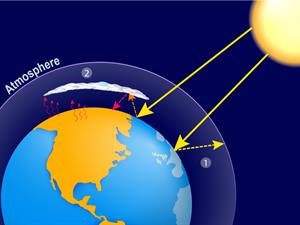PDF chapter test TRY NOW
Other planets are either too hot or too cold to live on, whereas Earth has a vast diversity. On the other hand, Earth has a stable temperature.
What makes Earth a different and favourable place to live?
The answer is Earth's atmosphere, which is a thin blanket of air surrounding the Earth from all sites.
As we studied earlier, the air is a mixture of gases that protect us from the harmful radiation from the sun. However, this stable temperature rises every day and oceans are getting warmer as climate are changes.

Rise in temperature
Let study why these changes are happening and what should we do to stop all these things.
How does the Earth get warmed?
The surface of land and ocean absorbs the radiation from the sun. In turn, they release infrared radiation or heat into the atmosphere. Specific gaseous present in the atmosphere absorb the infrared rays and reradiate the heat in all directions. Hence, these gases maintain the temperature of the Earth’s surface.

The sun's radiation warms the Earth
The gases which absorb these radiations are called greenhouse gases, and the effect is called greenhouse effect.
The greenhouse effect is essential to keep our Earth warm. Without this effect, the temperature of the Earth's surface would have been \(-20°C\) to \(-40°C\).
Greenhouse gases:
Carbon dioxide (\(CO_2\)), nitrous oxide (\(N_2O\)), methane (\(CH_4\)), chloro fluorocarbon (\(CFC\)), ozone or trioxygen (\(O_3\)), etc.
The increased level of these gases increases the temperature of the Earth’s surface. This increased greenhouse effect is caused due to an increase in air pollutants, resulting in the average increase in temperature of the atmosphere. This phenomenon is called global warming.

Global warming
